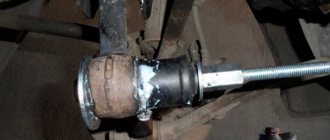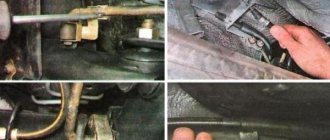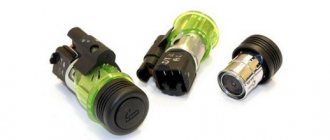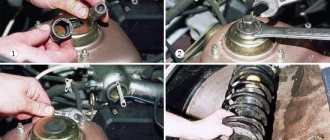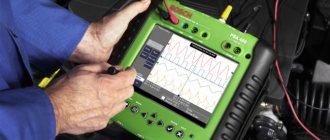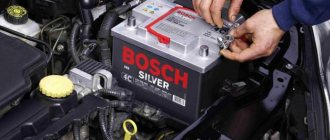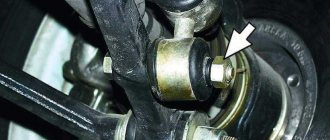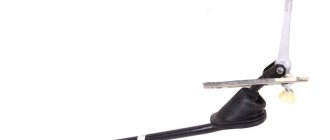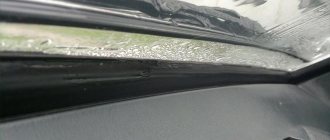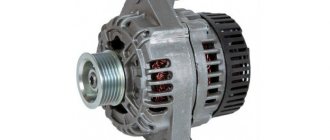Pros and cons of increasing the clearance of the VAZ 2110
Despite the global trends regarding the relatively low “landing” of cars, this is, frankly speaking, unacceptable for Russian roads. The achievements of the creators of the “ten” include the fact that the ground clearance on the VAZ 2110 is quite sufficient, one might say optimal for city conditions and paved roads (which for the most part leave much to be desired).
VAZ 2110 with lowered suspension
Why lower the Lada Priora?
On the roads of our country you can often find “Priors” with a low landing. The main reason why owners resort to this solution is to improve the appearance of the car. Lowering allows you to give the car a sporty look. In this budget way, the VAZ 2170 can be distinguished from the road traffic. When lowering work is carried out correctly, the following benefits can be obtained:
- reduce roll when cornering;
- improve the handling and behavior of the car at high speeds.
Lowering the suspension improves the appearance and handling of the car
One of the main disadvantages of lowering a car lies in the quality of the roads: any hole or unevenness can lead to serious damage to body elements or vehicle components (bumpers, sills, engine crankcase, exhaust system). Due to the low seating position, the owner has to visit a car service much more often to fix certain problems. Therefore, if you want to make your “Priora” below, you need to take into account the following disadvantages of such a procedure:
- you will have to plan your route more carefully;
- incorrect lowering can lead to rapid failure of suspension elements, in particular shock absorbers;
- Due to increased suspension rigidity, the level of comfort decreases.
Specifications
So, if we consider the factory design characteristics, then on all types of VAZ 2110 (and they were produced with sedan, hatchback and station wagon bodies), the ground clearance should be at least 165 mm - from the road to the oil pan, 140 mm - to the lowest point of the muffler. For 1.5 liter engines there is another indicator - the clearance to the catalyst must be at least 130 mm.
Dimensions of VAZ 2110
Owner reviews
- Alexey, Smolensk. In 2005, he became the proud owner of a VAZ-2110 with a 1.6-liter engine. Engine power 80 horsepower. The manual transmission works smoothly and fully reveals the potential of the good old engine. Before the “ten” I had a Moskvich and a VAZ-2106. Ten is much more comfortable and dynamic. It has excellent directional stability at high speeds. Now the mileage is 100 thousand kilometers, fuel consumption is about 10 liters maximum - in the urban cycle. The sedan is quite reliable and comfortable; there is enough space in the cabin for four tall passengers. The quality of materials is a solid C grade. The velor seats are comfortable, and by the way, the front seats are heated. Ground clearance of 170 mm is enough for Russian roads, as well as light off-road conditions. So, it’s still worth driving for another three years, and then selling ten.
- Yaroslav, Moscow region. I own a VAZ-2110 sedan from 2000. The car was inherited from my father and is still running. Version with a 1.5-liter engine. I recently updated my car, especially since there was a suitable reason for this - the car was wedged between a Mazda 3 and a Ford Focus - that’s a “small” accident. We had to replace the bumper, hood, and front fenders, but the “TV” remained intact. With further use, I gradually updated the car - installed new rain sensors, dampers, nozzles, supports, racks, wheels, sound insulation, electrical, wiring, etc. In short, in the end the car began to shine in new colors. Probably, if it weren’t for the accident, I wouldn’t have thought about updating at all. The car is still confidently standing on the given trajectory and does not wander on the track. There is no need to steer at high speeds, as directional stability is at a high level. The suspension is moderately stiff and well suited for bad roads. Due to the ground clearance of 170 mm, the car tilts in turns, but the car has excellent cross-country ability. In Russian conditions this is more important.
- Igor, Primorsky Krai. The car was purchased six months ago. Version 2001, with a 1.5 liter engine. The actual mileage at the time of purchase was 68 thousand kilometers. According to the second owner (it turns out that I am already the third owner), the car was in a warm garage until 2010. All consumables were changed on time - but when I heard this, I immediately wanted to go to the service center for diagnostics. The owner kindly agreed. The chassis was in good condition. The ground clearance of 170 mm is original and has not been changed. During six months of operation, no serious breakdowns occurred. About two weeks ago the front panel began to creak on the right side, but this is not critical. In general, something in the car constantly creaks, rings, rumbles - age, alas, takes its toll. The car looks almost like new - it was repainted in silver metallic before being sold. I liked the 10 for its comfort and convenience, practicality and good cross-country ability. Maintenance costs are the lowest in class.
- Konstantin, Ufa. I drive a VAZ-2110 2008. Now the mileage is 90 thousand kilometers. The car was exported from Estonia. Over the course of ten years, I installed a new vacuum booster, changed the speed sensor, front brake cylinders, heater and chassis elements. By the way, the pendant is in perfect condition. It is almost impenetrable, can withstand driving on broken roads, rough terrain, etc. Special thanks to AvtoVAZ for the ground clearance of 170 mm. The cross-country ability of the car will be the envy of many crossovers. I use the car every day, now I work as a taxi driver. Fuel consumption with a 1.5 engine is about 9-10 liters when loaded. It's comfortable to sit in the cabin; you can drive over tram tracks and speed bumps at a decent speed.
"Lifting" the machine
In principle, as we have already noted, this is enough for a more or less comfortable ride. But, of course, many people want to “raise” the VAZ 2110 a little more, based on their realities.
“Raised” VAZ 2110
We will tell you how you can actually do this. But let us warn you right away: “raising” the car above the asphalt level entails a number of unpleasant consequences:
- Clamping the springs, firstly, will lead to a decrease in comfort while driving, and secondly, the shock absorbers will suffer as a result, which will not be able to cope with their responsibilities;
- The suspension also suffers from too stiff springs, as this leads to increased loads on it;
- Corrosion is inevitable when using aluminum spacers;
- By increasing the ground clearance of the VAZ 2110, car owners risk the stability of the car while driving. The fact is that the center of gravity shifts, the car can rock, and in some cases it can even roll over. Therefore, experts strongly recommend not increasing the ground clearance by more than 5 cm. That is, the maximum limit should be no more than 170 mm!
Lowering springs SS20 Racing for VAZ
The SS20 Racing lowering springs are a new addition to the SS20 SPORT series of products for drivers who prefer a fast, active driving style. These are springs for those who care not only about the appearance of the car, but also about the correct operation of the suspension and steering when the ground clearance is lowered, confidence and safety on sharp turns.
SS20 Racing lowering springs have the following features
- made of high-quality Japanese steel using the cold-winding , which significantly increases the service life;
- have progressive characteristics: optimal suspension stiffness at low loads and a proportional increase in stiffness as the vehicle load increases, during roll when cornering or extreme braking;
- matched in pairs with identical characteristics, which ensures even lowering without body distortion;
- work without shrinkage 2 times longer than hot-rolled springs;
- the weight of the springs is reduced to 25% compared to the standard ones (depending on the car model);
- have a durable and resistant powder coating that protects against corrosion;
- have a polyurethane protective braid that protects the coils from damage when closed;
- When installed with SS20 Racing Series shocks, these springs provide your choice of -30, -50, -70 or -90mm drop.
Lowering a car or reducing ground clearance is one of the most modern areas of tuning today. To give their car confidence in driving, stability when maneuvering at a decent speed, and simply make it more stylish and sporty, car owners use different methods.
Some people simply cut through the springs due to lack of information or finances. You can’t expect a super effect from such economical tuning. But it’s cheap, and the car looks sporty and stylish in appearance. But you have to pay for this with convenience - you ride “like on a stool”, strong vibration shakes up the interior and everything starts to rattle. But this is not even the main thing: when cutting standard springs, it is impossible to achieve their identical characteristics, and this method leads to deformation and weakening of the body, gradual destruction of the front suspension cups, hard metal impacts on the body, and the appearance of cracks. And these are irrevocable serious losses that significantly reduce the performance and cost of the car.
Another option is that if you have the financial means, you can buy expensive suspension parts from the best manufacturers and assemble everything together. But it is not a fact that after this you will get what you dreamed of. Because to lower a car you need not only good expensive hardware, but also their coordinated work and the correct calculation of each suspension element. Moreover, it is necessary to take into account the changes made to the suspension geometry, and try to maintain the controllability and comfort of the car, and not disrupt the operation of the braking system.
We hope that the previous arguments were convincing. All this led us to the creation of KITs for lowering (“kits” - translation from English), in which springs play one of the main roles in lowering. Springs - it seems, what could be simpler - a piece of wire twisted into a spiral, that's all. But for some reason, not every manufacturer can produce high-quality, reliable and durable springs that will work stably, will not sag over time and, most importantly, will be manufactured exactly according to the design parameters.
Good springs are technologically sophisticated products made from high-quality metal. The working load of a lowering spring is much higher than that of a regular spring. Lowering springs (sport springs) absorb the same shock from the road as regular springs, but they are short and must absorb bumps with less compression travel of the suspension.
This feature was taken into account when designing and testing the SS20 Racing lowering springs. As a result, due to special Japanese steel, the use of the cold coiling in production, a durable protective coating and a special protective braiding that protects the coils from damage when closing, SS20 Racing lowering springs work without shrinkage twice as long as the hot coil springs that are widely available today time on the market.
sports springs have progressive characteristics, that is, they provide lowering of the car without loss of comfort: optimal suspension stiffness at low loads and a proportional increase in stiffness as the vehicle load increases, during roll in a corner or sudden braking.
Depending on the vehicle model and the amount of lowering, the weight of SS20 Racing springs is reduced by up to 25% compared to standard springs (except for springs SS30136 and SS30137). Reducing the weight of springs, together with reducing the weight of shock absorbers, reduces unsprung masses in the car’s suspension, which has a positive effect on driving performance, reduces dynamic loads in the suspension, improves acceleration and braking dynamics and contributes to improved handling.
The energy intensity of the suspension with lowered springs is calculated and maintained due to increased spring stiffness. Thanks to this, the lowered car remains comfortable, and shocks to the body when overcoming bumps are reduced.
All SS20 Racing springs are tested on a control stand and are selected in pairs with the same characteristics, so they provide uniform lowering without body distortion, stability and driving safety.
Marking
In addition to lowering springs, the SS20 company produces classic hot-coiled springs and Gold springs with variable coil pitch.
Spacers
One way to increase the clearance is to install spacers - a kind of spacer supports that can be found in stores and car markets. They are installed between the body and the support of the VAZ 2110.
Spacers for the concept of the rear of the car
They come in three types:
- made of plastic – they have practically no flaws, are quite durable and last a long time;
- polyurethane ones are also wear-resistant, but when the car “flies” into a hole, it is strongly compressed, which is why the impact becomes very noticeable;
- aluminum ones “peel” the paint from the supports and body, thereby increasing and accelerating corrosion.
Shock absorber modification
When transporting large loads (and often VAZ 2110 owners do not listen too much to recommendations regarding load capacity), the car seriously “sits down” and its ground clearance is significantly reduced.
If you have to constantly carry heavy things, it makes sense to install springs with class “A”. Naturally, they will make the shock absorbers stiff, and you will only be comfortable in a heavily loaded car, and without a load it will shake like on a cart.
There are also s, which are installed between the spring coils and do not allow the shock absorber to compress too much.
Interturn spacers in the shock absorber spring
In principle, such a car will no longer sag significantly under load, as well as nod off, but the shock absorber stroke will decrease and it will fail faster.
Lowering the car
Surely every owner would like to make his car look beautiful and attract attention on the street. There are many different ways to give your car an unusual look.
Someone lifts or lifts cars, someone tints or paints them, and someone lowers their iron horse. People perceive their relationship to car undervaluation as 50/50: some like it, some don’t. But if you came here, you definitely decided to lower your car. This article describes in detail all the methods of lowering a car using the example of Lada Priora and VAZ 2110.
Ways to lower a car
There are several ways to lower a car:
- Washed down the springs (the most budget-friendly and not the safest way)
- Installing short-travel struts (the most popular lowering method)
- Installation of pneumatic struts (the most expensive option)
Next, we will take a closer look at each of the options for lowering the car. Starting from the cheapest to the most expensive method.
Method one: Sawn springs
This method of underestimation has found popularity among young people. This is due to the fact that most young people do not have large sums of money to spend on tuning their cars. This method of lowering a car is the cheapest and fastest, but far from the most reliable and safe.
So, let's take a closer look at how to cut springs on the Lada Priora and VAZ 2110.
Washed down the springs on the VAZ 2110
The suspension of the Priora and 2110 cars is slightly different in the design of the shock absorber strut. The Priora uses a barrel spring, while the VAZ 2110 uses a coil spring.
Coil spring VAZ 2110
In order to lower the car using the spring method, you need to decide on the amount of lowering of the car. It is not recommended to cut the springs more than 3 turns at the front, since the strut will compress and the upper cup of the shock absorber will rest against the bump stop, therefore, the shock absorber may not function properly.
The springs of the rear shock absorbers can be sawed up to 5 turns, after which the same thing awaits you as with the front shock absorbers, the bump stop will rest against the rear spar. It follows that the shock absorber will not work correctly and there can be no talk of any driving comfort.
Washed down the springs on the Lada Priora
You can file the spring on a Priora, but it is not recommended to saw the front springs. The front spring of the Priora, as described above, has a barrel shape, therefore, after washing it down, it will lose its shape and will not fit into the groove of the shock absorber cup. Some craftsmen, after washing down such a spring, heat it up and give it a similar shape.
It is strongly not recommended to use this method, since when heated, the spring loses its properties and elasticity, becomes more fragile and susceptible to rupture or breakage, which can lead to dire consequences.
Sawed barrel spring
The rear springs of the Priora can be cut in exactly the same way as the springs of the VAZ 2110, because they are absolutely the same.
Step-by-step instructions for cutting down a spring
In order to safely file down the spring, the strut must be removed from the vehicle.
The first step is to prepare the necessary tool. It's better to use a key set
Removing the front struts
To remove the front struts you will need the following tools:
- Open-end wrenches for “13”, “17”, “19”, “22”;
- Hexagon at "6";
- Socket heads or wrenches for “13”, “17”, “19”, “22”;
- Anti-rust liquid WD-40, etc. (by the way, if you don’t have WD-40, you can use kerosene, antifreeze or diesel fuel)
- Hammer, pry bar and pliers
- Steering wheel end remover.
Steering end puller
So, let's start disassembling the car
- 1. It is necessary to jack up the side on which the spring will be washed down, having previously loosened the wheel mounting bolts 4 pcs. Do not forget to put chocks under the rear wheels of the car so that it does not roll forward or backward.
- 2. Remove the wheel from the car and place it under the threshold of the car. This action will help prevent damage to parts of the machine if it falls from the jack.
- 3. Next, you should loosen the nut securing the rod to the front shock absorber support in advance; for this you will need a hex socket set to “6” and a wrench set to “22”.
- 4. Unscrew the steering end mount with the head on “17”, having first pulled out the cotter pin. And we press it out of the rack axle using a puller or a hammer and a pry bar.
- 5. Pull out the brake hose and ABS wire from the seats in the rack.
- 6. Unscrew the bolts securing the strut to the steering knuckle using keys “17” and “19”.
- 7. Unscrew the three bolts securing the shock absorber support to the strut with a head set to “13”.
- 8. Take out the stand.
Next we should proceed directly to disassembling the shock absorber, here we will need spring ties
- 9. We tighten the spring with ties on both sides.
- 10. Unscrew the nut securing the support and remove it, then remove the spring and the bump stop with the boot.
The stand is disassembled, you can start cutting. The number of turns must be measured from the beginning of the turn on the spring. We saw the spring with a grinder.
We assemble the rack in the reverse order. You should pay attention to the washers under the rack support and install them in the correct sequence as shown in the photo.
The sawn spring must be installed with the cut coil down.
We carry out exactly the same action with the opposite side.
Removing the rear struts
To remove the rear struts you will need much less tools than to remove the front ones.
Tools required to remove rear struts:
- Keys to "17", "19"
- A special key for unscrewing the rear shock absorber rod.
Step-by-step instructions for removing the rear shock absorber of Lada Priora and 2110
There is no need to use zip ties to replace rear shock absorbers
- Loosen the bolts securing the wheel to the hub.
- In the luggage compartment of the car, bend (unscrew if necessary) the trunk lining so that access to the rear spar is free. Loosen the nut securing the rear shock absorber rod to the spar.
- Jack up the side on which the spring will be cut. Do not forget to put chocks under the front wheels of the car so that it does not roll forward or backward. Remove the wheel from the car and place it under the threshold of the car. This action will help prevent damage to parts of the machine if it falls from the jack.
- Unscrew the bolt securing the shock absorber to the rear beam of the car.
- Unscrew the shock absorber rod from the rear side member of the vehicle.
- We take out the strut, you need to lower the strut all the way down, squeeze the shock absorber rod, pull out the spring with the boot and bump stop, and then the shock absorber itself.
That's it, the rear strut has been removed from the car, you can start cutting down the spring.
It is necessary to count the number of turns and cut the spring exactly opposite the beginning of the spring turn.
Reassembly of the rear shock absorber should be done in reverse order.
Examples of cars with sawn springs
Saw springs front 3 turns rear 5 turns Saw springs front 2 turns rear 3 turns
Advantages and disadvantages of sawn springs
Disadvantages of lowering a car by filing down the springs:
- There is no comfort when driving such a car.
- There is no way to travel on a country road.
- The spring may fly out of the shock absorber cup.
- Immediate failure of shock absorbers.
Advantages of lowering a car by filing springs:
- Cheap and easy to use.
Method two: Short-travel struts
This method is currently used along with cutting down springs. On the streets of the city you can see a huge number of cars with such racks. It gained wide popularity due to its simplicity, reliability and comfort. Also, short-travel struts have a wide range of vehicle height options. Any car enthusiast can choose the optimal understatement for himself.
Lowering with the help of short-stroke struts practically does not change the design of the car and does not cause any harm to it, unlike silting of the spring. Lowering in this way occurs by changing the height of the rod itself and the strut cartridge, and by installing an already obviously shortened spring.
Types of short-travel struts and springs
There are a large number of short-stroke struts that have their own characteristics. Let's look at a few examples of racks.
Short-travel struts are classified by lowering height, that is, each strut has its own size.
What do these numbers mean?! The number indicates the size in mm by which the stand rod and cartridge are shortened. Therefore, a rack with index -30 is shortened by 30 mm, a rack with index -50 is shortened by 50 mm, etc.
Racks are also classified according to their stiffness zone. Comfort and sport.
Comfort racks
Such struts have a softer degree of compression, which ensures comfort when driving. There is no shaking or knocking in the car when using such racks.
Sports racks
Sport struts are used for tuned cars with non-standard engines. Such struts provide positive dynamics when driving on the highway; the car experiences minimal roll when turning.
Springs
In combination with short-throw struts, shortened springs are used.
The classification of such springs is similar to the classification of struts. Springs are: -30, -50, -70, -120. The spring stiffness is exactly the same as that of the struts: comfort and sport.
Variable Coil Springs
Such struts can be installed in standard places with standard components; for example, to install short-stroke struts there is no need to change the support bearing and boots.
The most popular brands of short-stroke struts and springs: SS20, ASTON, TechnoRessor and Demfi.
Examples of cars with installed short-travel struts and springs
Lada Priora with an understatement of -50
Advantages and disadvantages of short-travel struts
Advantages of short-travel struts:
- Comfort while driving;
- There is no damage to the car;
- Large selection of rack heights;
Disadvantages of short travel struts:
- Inability to adjust vehicle height;
- Difficult traffic on a country road;
Method three: Air suspension.
This method is the most expensive and difficult to install. To install the air suspension, the car must be completely disassembled. Install special equipment; besides, air suspension is not suitable for cold seasons. Quite often it happens that condensation appears in the tubes, which in cold weather can lead to a blockage in the air channel.
To install this method of understatement, qualified specialists will be required. Large set of tools and equipment. To install the air suspension you will need: a receiver, a compressor, hoses, pipes, special racks, sleeves, etc.
The installation of air suspension has not found much popularity due to its high cost and capriciousness. Due to the large amount of reagents on the road, air leaks often appear in the system, which makes it impossible to drive a car. Also, using a car in winter is quite problematic.
Advantages and disadvantages of air suspension
Pros of air suspension:
- Possibility of changing clearance
Disadvantages of air suspension:
- High cost and complexity of installation;
- Inability to move in cold weather;
- Taking away useful space in the trunk;
Bottom line: to lower a car, it is best to use short-travel struts. Such racks are the most suitable option for everything in terms of price and quality.
It should be noted that with a measured lowering of -120 mm, it is necessary to saw the right spar. Due to the very low lowering, the right-hand drive wheel will touch the car body. The photo shows how the drive rests on the car body.
Also, when carrying out any actions, it is imperative to have the wheel geometry done at a service station upon completion of the repair.
"Houses"
Another method of increasing ground clearance is to install so-called “houses” on the rear suspension. The “houses” have special holes through which the ground clearance is adjusted, and they are installed between the eyes of the rear suspension beam and the bottom of the shock absorber.
Spacers-houses
But experts generally cannot come to a common opinion - whether the “houses” of the VAZ 2110 help or harm it. Some people believe that they are needed when the springs have sagged, and with their help it will be possible to raise the rear of the car. Others suggest replacing the springs and not “fencing up houses”.
Safety
Whatever method of increasing the ground clearance on the VAZ 2110 you choose (if you need it, of course), remember that safety comes first. You want to get a car that will be more stable on the road, and not ready to roll over every minute even on a small obstacle?
Therefore, be sure to adjust the suspension to increase its elasticity. Swap out the regular tires on your car for low-profile tires. To ensure this, also install additional stabilizers.
